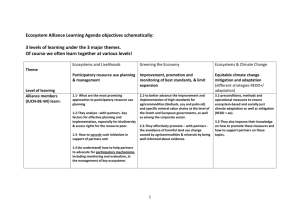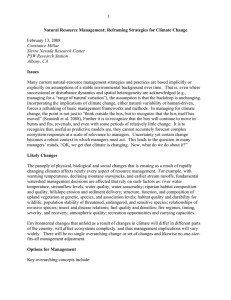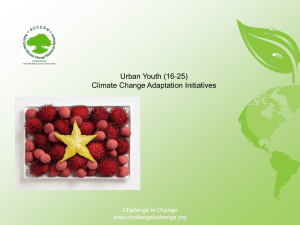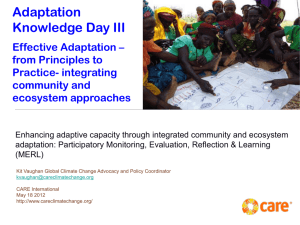March 22-23 Presentations_Climate Change Commission 2
advertisement
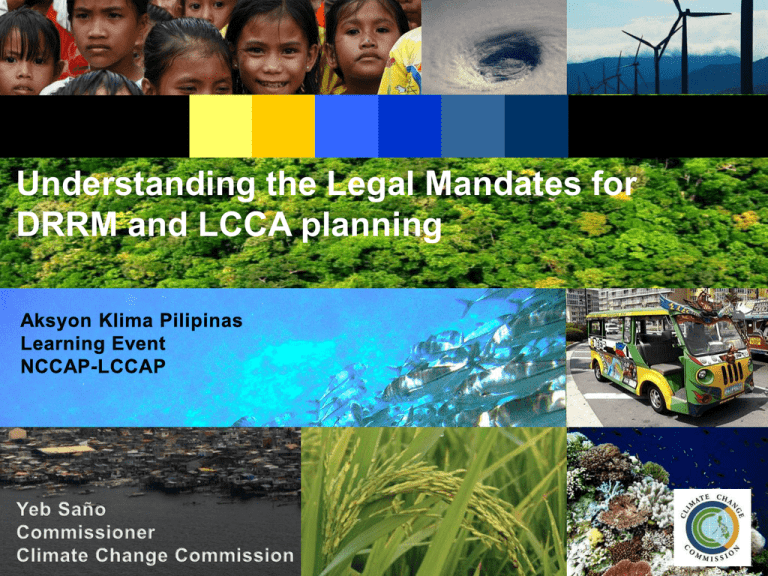
Understanding the Legal Mandates for DRRM and LCCA planning Based on the most recent developments in the global efforts to solve climate change, we are in for a very challenging future Co-benefits No regrets Types of adaptation Autonomous Planned Levels of adaptation Species, Genus Ecosystems Biogeographic zones/ clusters Ecoregions Levels of climate action Community Province/City/Municipality Regional National International Regional Adaptation must address root causes National Framework Strategy on Climate Change • • • • • CLIMATE CHANGE • • • • Increasing temperatures Changing rainfall patterns Sea level rise Extreme weather events VISION: A climate risk-resilient Philippines with healthy, safe, prosperous and self-reliant communities, and thriving and productive ecosystems CLIMATE PROCESS Energy DRIVERS Transport Land Use Change & Forestry Agriculture Waste SUSTAINABLE DEVELOPMENT SOCIETY Goal: To build the adaptive capacity of communities and increase the resilience of natural ecosystems to climate change, and optimize mitigation opportunities towards sustainable development. MITIGATION • • • • • • Capacity Development Knowledge Management IMPACTS AND VULNERABILITY IEC & Advocacy Energy Efficiency & Conservation Renewable Energy Environmentally-Sustainable Transport Sustainable Infrastructure National REDD+ Strategy Waste Management Gender Research & Development Mainstreaming Technology Transfer CROSS-CUTTING STRATEGIES • Ecosystems (River Basins, Coastal & Marine, Biodiversity) • Food security • Water resources • Human health • Infrastructure • Energy • Human society ENVIRONMENT ECONOMY ADAPTATION • Enhanced Vulnerability and Adaptation Assessments • Integrated Ecosystem-Based Management • Climate-Responsive Agriculture • • • • Water Governance & Management Climate-Responsive Health Sector Disaster Risk Reduction & Management Climate-proofing of Infrastructure Multi-stakeholder Partnerships Financing Valuation Policy, Planning & Mainstreaming MEANS OF IMPLEMENTATION • 2011 to 2028 • address urgent and immediate needs and concerns relating to the dangerous consequences of climate change to vulnerable sectors such as agriculture, water resources, ecosystems, humans and infrastructure services • Keeping the Promise in the President’s Social Contract • Adopted 11-22-11 NCCAP: Ultimate Goal Build the adaptive capacities of women and men in their communities, increase the resilience of vulnerable sectors and natural ecosystems to climate change, and optimize mitigation opportunities towards gender-responsive and rights-based sustainable development Intermediate Outcomes Ecological and Environmental Stability Human Security Water Sufficiency Climate-Smart Industries and Services Sustainable Energy Knowledge and Capacity Development Food Security Enhanced adaptive capacity of communities, resilience of natural ecosystems, and sustainability of built environment to climate change. Successful transition towards climate-smart development. Ultimate Outcomes How do we localize climate action? Key Directions LGUs located within Ecotowns to be areas of priorities for green growth investment and payment for ecological services (PES) Comprehensive National Vulnerability and Adaptation Assessment & Climate Risk Analysis National Natural Resource Accounting (Total Economic Valuation) Establish the Ecotowns in Key Biodiversity Areas (sensitive forest, coastal and marine ecosystems, small islands, food baskets) The whole National Budget as Climate Change Adaptation Budget CCT+CCA with protection of natural resources as the condition Climate Financing for Adaptation + To manage the unavoidable and avoid the unmanageable Local Climate Change Action Plan LGUs as frontline agencies Barangays to be directly involved with LGUs in prioritizing CCA and DRR issues CCA and DRR to become a regular function of municipal and city LGUs Is adaptation all about climate change Adaptation is about paradigm shifts It is a useless life that is not consecrated to a great ideal. -Jose Rizal Salamat! www.climate.gov.ph



